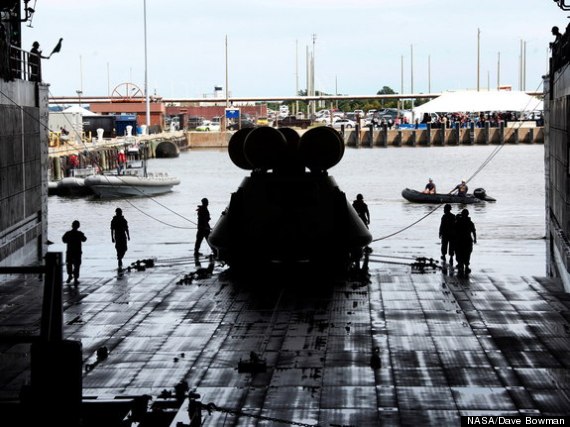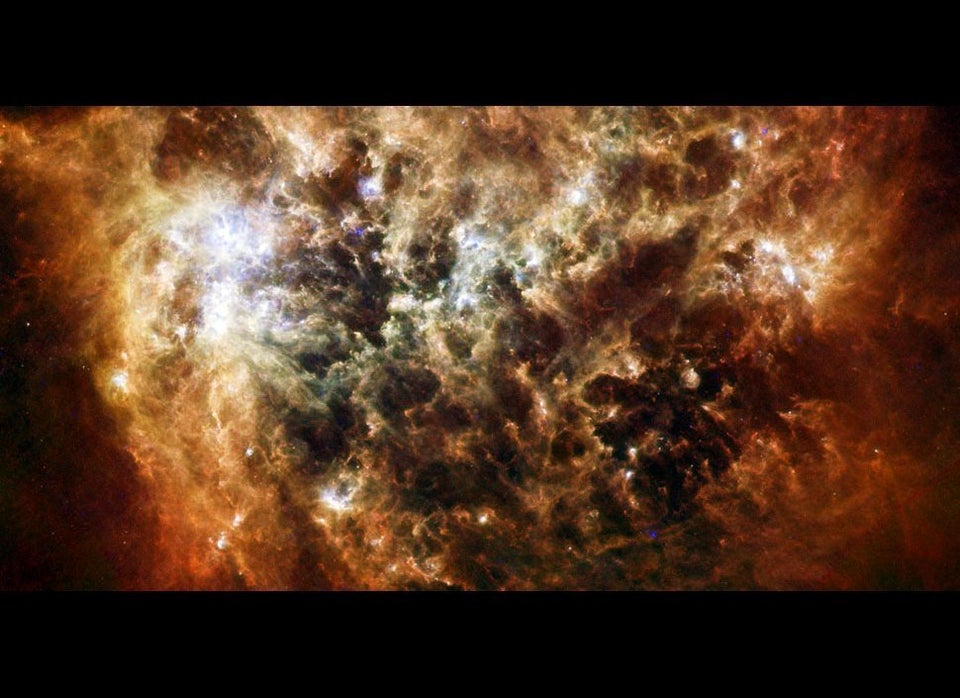A new test of NASA's future deep-space capsule for crews is reigniting the tradition of recovering NASA spacecraft from the sea.
In the still waters near a pier in Naval Station Norfolk in Virginia, a prototype Orion spacecraft was successfully brought on board a navy ship for the first time.
“It was nice to see how the ballet of it all performed,” said Lou Garcia, NASA recovery director, in a statement. [Photos: Orion Space Capsule's Parachute Test]
Navy divers put tow lines on the test capsule and brought Orion to an open space (known as a well deck) below the main deck of the U.S.S. Arlington. Once the spacecraft was safely inside, water inside the well deck was drained until Orion was flat on the surface.
It's been nearly 40 years since the last Apollo spacecraft — one that formed part of the Apollo-Soyuz mission — splashed down in the Pacific in 1975. After a generation of landing space shuttles on land, NASA chose to shift back to water-based landings for Orion as it eyes missions beyond Earth orbit.
 An Orion test spacecraft is silhouetted on the carrier deck after recovery test.
An Orion test spacecraft is silhouetted on the carrier deck after recovery test.
First Orion test flight in September 2014
This particular test took two years to accomplish as NASA and the Navy worked together on the recovery procedures. The landings will be out in the choppy ocean, but they chose as a first step to do a test within a controlled environment – the waters next to a pier.
"This allows us to practice our procedures in a benign environment with no ship movement and minimum wave action," Jim Hamblin, a landing and recovery element operations manager with NASA's ground systems development and operations program, said in a statement.
The next step is to do the procedures on the open water, which will happen around January 2014. Orion's first test flight, known as Exploration Flight Test (EFT)-1, is scheduled for September 2014.
EFT-1 will bring an uncrewed spacecraft 3,600 miles (nearly 6,000 kilometers) above Earth — about 15 times higher than the orbit of the International Space Station. Orion will then do a high-speed entry, traveling up to 20,000 miles an hour (32,000 kilometers an hour) before splashing down into the Pacific Ocean.
Engineers plan to gather information on Orion's flight systems, heat shield and other systems to refine the spacecraft's design before humans climb onboard later in the decade.
Follow Elizabeth Howell @howellspace, or SPACE.com @Spacedotcom. We're also on Facebookand Google+. Original article on SPACE.com.
Copyright 2013 SPACE.com, a TechMediaNetwork company. All rights reserved. This material may not be published, broadcast, rewritten or redistributed.
Support HuffPost
Our 2024 Coverage Needs You
Your Loyalty Means The World To Us
At HuffPost, we believe that everyone needs high-quality journalism, but we understand that not everyone can afford to pay for expensive news subscriptions. That is why we are committed to providing deeply reported, carefully fact-checked news that is freely accessible to everyone.
Whether you come to HuffPost for updates on the 2024 presidential race, hard-hitting investigations into critical issues facing our country today, or trending stories that make you laugh, we appreciate you. The truth is, news costs money to produce, and we are proud that we have never put our stories behind an expensive paywall.
Would you join us to help keep our stories free for all? Your contribution of as little as $2 will go a long way.
Can't afford to donate? Support HuffPost by creating a free account and log in while you read.
As Americans head to the polls in 2024, the very future of our country is at stake. At HuffPost, we believe that a free press is critical to creating well-informed voters. That's why our journalism is free for everyone, even though other newsrooms retreat behind expensive paywalls.
Our journalists will continue to cover the twists and turns during this historic presidential election. With your help, we'll bring you hard-hitting investigations, well-researched analysis and timely takes you can't find elsewhere. Reporting in this current political climate is a responsibility we do not take lightly, and we thank you for your support.
Contribute as little as $2 to keep our news free for all.
Can't afford to donate? Support HuffPost by creating a free account and log in while you read.
Dear HuffPost Reader
Thank you for your past contribution to HuffPost. We are sincerely grateful for readers like you who help us ensure that we can keep our journalism free for everyone.
The stakes are high this year, and our 2024 coverage could use continued support. Would you consider becoming a regular HuffPost contributor?
Dear HuffPost Reader
Thank you for your past contribution to HuffPost. We are sincerely grateful for readers like you who help us ensure that we can keep our journalism free for everyone.
The stakes are high this year, and our 2024 coverage could use continued support. If circumstances have changed since you last contributed, we hope you’ll consider contributing to HuffPost once more.
Already contributed? Log in to hide these messages.
 An Orion test spacecraft is silhouetted on the carrier deck after recovery test.
An Orion test spacecraft is silhouetted on the carrier deck after recovery test.